After years of speculation and theories, Andrew Irvine’s foot inside a boot has finally been found on Mount Everest, his presumed resting place of over 100 years, since 1924 when Andrew Irvine, popularly known as Sandy disappeared mysteriously in the upper part of Everest with his climbing partner George Mallory. Sandy’s remains were found at the base of Everest
The finding was more of an accidental stumble upon by a team from National Geographic led by Jimmy Chin while coming down the Central Rongbuk Glacier on Everest’s North Face route, the team found an old oxygen tank from 1933, from a British expedition that happened nine years after Mallory and Irvine went missing. This got them thinking, especially since an ice axe thought to be Irvine’s was found in 1933 on the northeast ridge, quite a distance below where Mallory was discovered. This boot belonging to Sandy was discovered at an elevation of about 5300m meaning it was way below where Percy Wyn-Harris, a member of the fourth British Everest Expedition discovered Andrew Irvine’s ice axe at an elevation of 8,460 metres (27,760 ft), about 20 metres (66 ft) below the ridge and some 230 metres (750 ft) below the First Step.
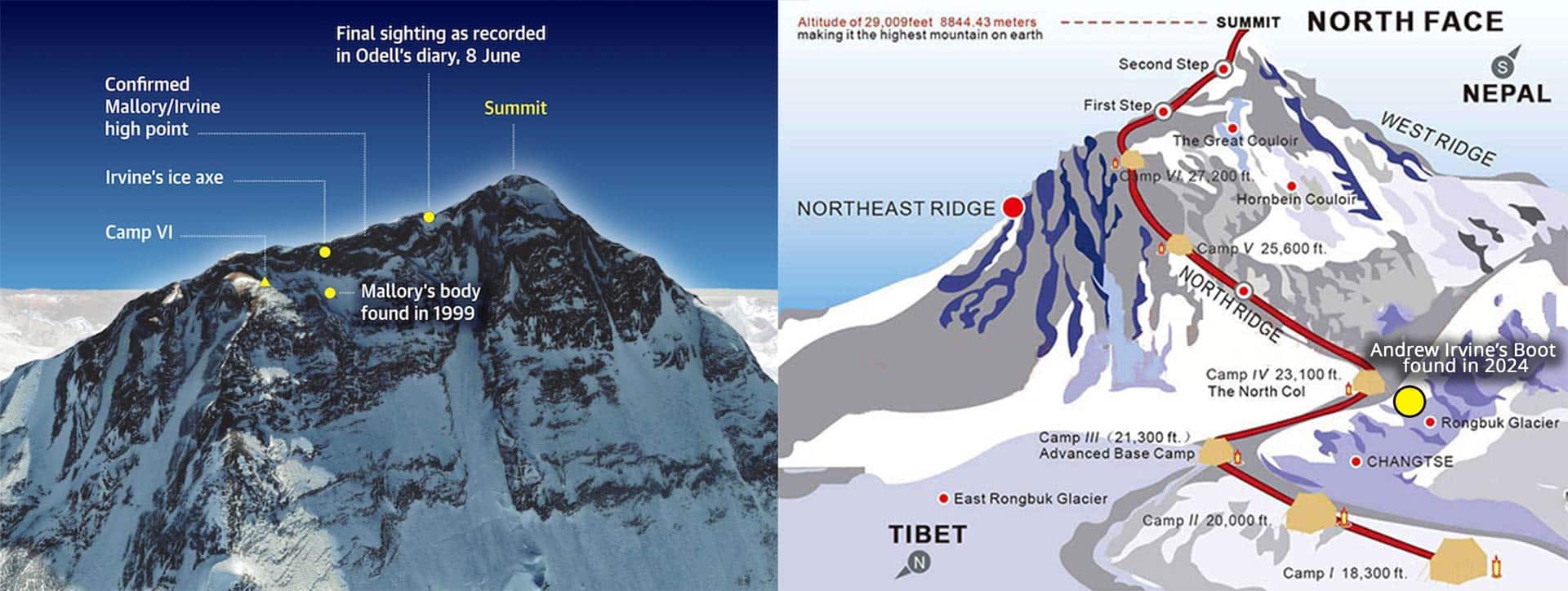
The oxygen tank being so far down the glacier made them think that maybe Irvine’s body could have also slid down further. With this in mind, they started looking around the area. A few days later, while moving through the glacier’s rough terrain, Erich Roepke, one of the team members, saw something odd sticking out of the ice. As they got closer, they saw it was an old boot with part of a human foot inside. When Chin checked inside the sock, there was a red label with “A.C. IRVINE” sewn on it, which confirmed they had found the remains of Andrew Comyn “Sandy” Irvine.
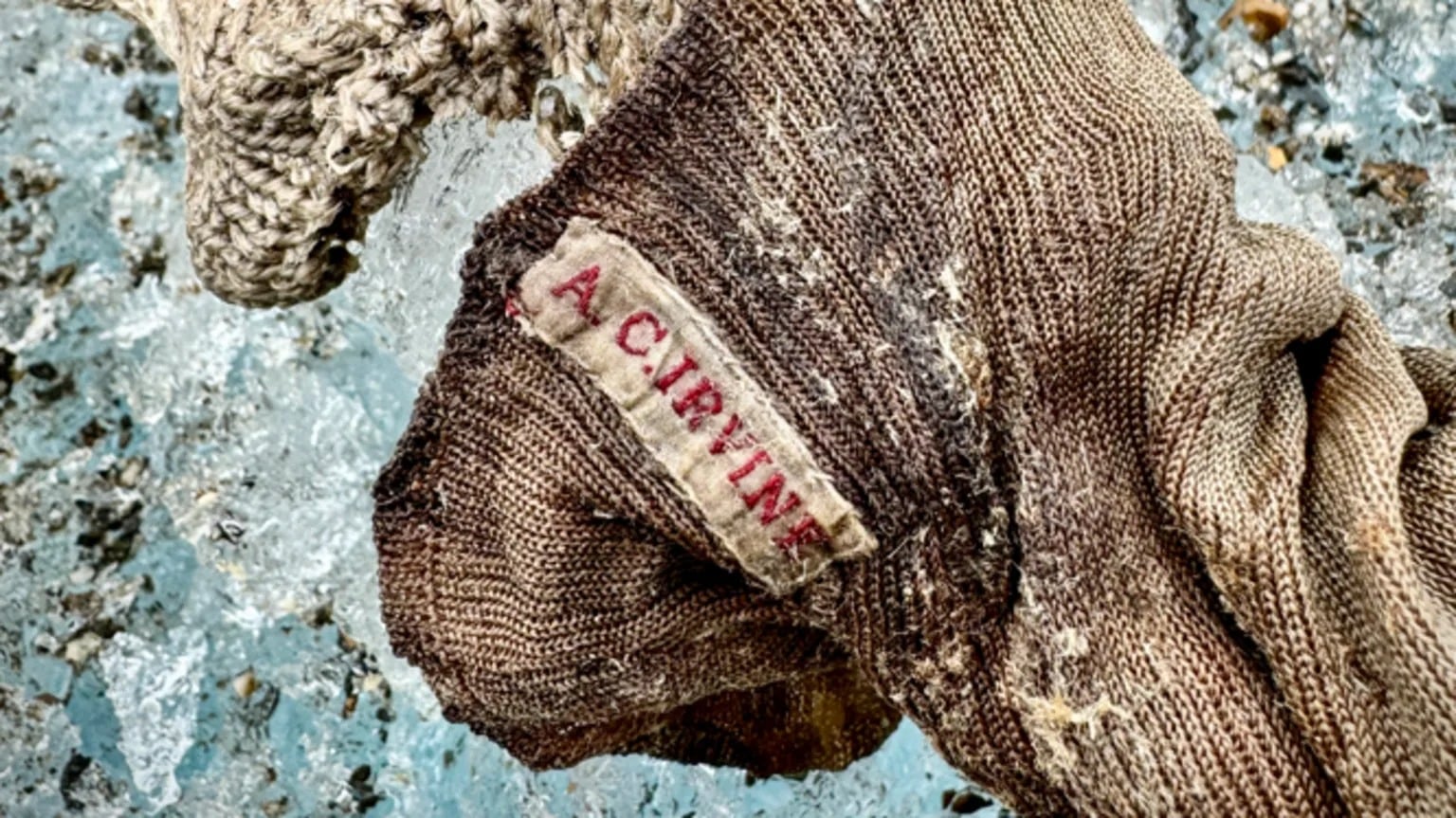
Some of the remains of legendary mountaineer Sandy Irvin have been discovered on the Rongbuk Glacier in Tibet. This is certainly the biggest break in the mystery of Mallory and Irvin in at least 25 years. The mystery of George Mallory and Andrew Irvine, who vanished on Everest in 1924, has intrigued the world for nearly a century. Did they reach the summit before their tragic end? In 1924, Britain aimed to restore its exploration prestige by conquering Everest. Mallory, a seasoned climber, and Irvine, a young engineer, embarked on this daring mission.
Tragically, they disappeared on June 8, leaving behind a nation in mourning. For decades, climbers and historians have debated whether Mallory and Irvine reached Everest’s peak. Mallory’s body was found in 1999, but the camera that might have held summit evidence was missing, leaving the question unanswered.
Filmmaker and mountain climber Jimmy Chin posted on social media about a surprising discovery they made by chance. While filming a ski trip, Chin and his team, Erich Roepke and Mark Fisher, found something unexpected. George Mallory’s body, who was Andrew Irvine’s climbing partner, was discovered 75 years after their accident close to a place called the Yellow Band, just before Camp 4, back in 1999 by Jimmy Chin’s friend and mentor, Conrad Anker. However, they never found the body of Andrew Irvine, which has led to many theories and guesses about what happened to him.
View this post on Instagram
Sandy Irvine, seen here on the left with his companion, the great mountaineer, George Mallory. Mallory was asked just before their 1924 expedition why he wanted to climb Everest. His famous answer was, “because it’s there.”
But the two explorers disappeared together during their ill-fated attempt to summit the highest mountain on Earth. Irvine and Mallory were last seen less than 300 metres from the top, sparking a century of speculation as to whether they succeeded in their goal before they lost their lives. Now, National Geographic filmmaker Jimmy Chin has led a mission that has found what’s believed to be Sandy Irvine’s partial remains.
The team discovered a foot inside a 1920s leather boot with a name tag, AC Irvine, stitched into the sock. Hopefully, this leads us to have a greater understanding, a bit more clarity about the events of that fateful climb. That’s the hope, and I think that, in that, lends the importance of the find.
A member of Irvine’s family has volunteered to provide a DNA sample to allow the remains to be scientifically identified. And for the family, this is a moment to remember a brave young man with an appetite for adventure. With this discovery, it is evident that the story of Sandy Irvine has affected all of them.
Although he’s an important historical figure and his name is inextricably linked with George Mallory and Everest and the tragedy of 1924, he was a young man. He was 22 at the time and was a good skier. But above all, he was a young man who just took life and lived it. The discovery has not solved the mystery of whether Sandy Irvine and George Mallory made it to the summit of Everest, but it has revealed that the site of his great adventure became Irvine’s final resting place.
How the team stumbled upon the foot and boot of Sandy Irvine
A boot and sock were discovered sticking out of the glacier by a team there to film a ski descent of the Hornbine Couloir.
The team was unsuccessful and upon their return back to base camp noticed this without even looking for it. It was completely serendipitous. It was quite obvious to the team that was led by Jimmy Chin, the famous mountain climber, and Oscar-winning film director, that this was an old boot.
It looked exactly like the boot that George Mallory was wearing when he was discovered in 1999. Upon closer inspection, Jimmy Chin lifted up the sock and stitched on it was a label that said A.C. Irvin Andrew Komen Irvin. Absolutely amazing.
There were no other remains found. However, this is a truly historic discovery. Probably the most important thing over all of the fascination with this recent discovery is that Sandy Irvin was a human being. He has relatives who are still alive today and have great love for this man who lost his life in 1924. Julie Summers, Irvine’s great-niece, expressed her emotional reaction to the discovery.
Julie Summers who wrote the incredible literature of Andrew “Sandy” Irvin called Fearless on Everest, The Quest for Sandy Irvin, which talks about Sandy Irvin in a way that brings him fully to life. He was a vital and funny and intelligent young man and also is a congratulations to the team. Sometimes serendipitous discoveries are the greatest discoveries of all.
We’re not looking for something and we find it anyway. And that’s the most beautiful part of this story. The team that discovered these remains was a National Geographic documentary team with photographer Jimmy Chin, also along with filmmakers and climbers Eric Repke and Mark Fisher, a truly amazing team.
It was and will remain an extraordinary and poignant moment, she said. The Irvine family plans to compare DNA to confirm the identity, potentially solving this enduring mystery.

It would come as no surprise that the team was absolutely mind-blown by the discovery. And in the short article released by National Geographic, Jimmy Chin says that after they recognized in unison what had taken place, “we were all literally running in circles, dropping F-bombs”. That would make for great film content if you ask me.
It’s truly authentic and spur of the moment. I can imagine it. It must have been an amazing experience for them.
The question that really remains is, does this discovery shed any new light on the mystery of Mallory and Irvin? Can we make any deductions about what might have happened to George Mallory and Sandy Irvin a hundred years ago this year? Are previous speculations that the Chinese either removed or threw the body off of the mountain some years ago, really corroborate with these recent findings of Sandy’s remains?
Now we might have a clue on where he is on the forensic level. Well, right now, the discovery helps in some way but I don’t think that the find really tells us that much, to be perfectly honest but that’s at the same time where the problem lies in all of this. Rongbuk is a huge glacier.
It’s a huge collection zone. So it seems to me very difficult to draw any firm conclusion from that. It eliminates maybe one or two theories, but it leaves open very many possibilities still.
One of the logical assumptions would be that there are many ways how he could have ended up down there on the central Rongbuk Glacier. He could have fallen with Mallory all the way down, which by the way, is interesting that Mallory caught his fall up there and Irwin went all the way down to the base of the mountain. He could have been avalanched down there.
Everything is still possible. And every theory based on those various scenarios is still valid at this point.
So now it’s more like, let’s wait and see. Let’s wait if more will be found, if more information will get out. But I don’t see a definitive solution to the mystery by that find alone.
But still, there is the poignancy and the really calming feeling, that at least we know his final resting place and that is very, very comforting. Our condolences go out to Julie Summers, and the larger Irwin’s relatives. And I think that’s the feeling that prevails right now at the end of this very exciting day.
And what Julie Summers published so far in the book about Andrew Irvine brought this great sense of deja vu. You have the name tag, almost identical lettering, red lettering, like Mallory’s name tag. You have the old leather boot, which seems to have been a little bit different from that of Mallory, but an old leather boot.
Nonetheless, you could still see the nails on the sole of the boot. And this is such a deja vu, like remembering 25 years ago, sitting at Advanced Base Camp when Andy Pollitz came down and presented us with the boots and you were there. And that is what really keeps the story so alive.
And I like that we have now this mirror image, this analogy. We have the same image of artefacts from Irwin that we had of Mallory. And it’s a bit like Andrew is now stepping out of Mallory’s shadow a bit.
We have a similar image in mind. And that is great. And that is what I feel about this 100th anniversary year, 2024.
The story is becoming more complete, not necessarily solved, but it becomes more complete. We have this discovery of Andrew Irwin. There couldn’t have been a better timing than in this year.
And we have this beautiful biography of Ruth Mallory by Kate Nicholson, which is a stunningly beautifully crafted book. To me, it felt like, yeah, we have 50% of Mallory’s story, his better half, the story of his better half added. So that is great.
- Andrew Irvine: The lost body on Everest
- Noel Odell, the last person to see Irvine and Mallory alive 100 years ago
- What happened to Andrew Irvine and George Mallory’s Camera
- Frank Smythe ; The first professional mountaineer’s secret from 1936 Everest Expedition
- Freja Mallory, wants to mark 100 years since the disappearance of George Mallory, her great grandfather on Everest
- Climbing High: The Legendary Story of George Mallory
- George Mallory: Was he the first person to climb Mount Everest?
- Tenzing Norgay, the first sherpa to summit Mt. Everest
Where did they find the remains of Andrew Irvine?
The Rongbuk Glacier where they found the remains of Andrew Sandy Irvine, known for its beauty, is considered the most stunning glacier in China. It’s located very close to the Rongpuk Monastery, only about 300 meters away, and spreads across an area at elevations between 5,300 to 6,300 meters near the base of Mount Everest. This glacier sits in the Tibet Autonomous Region in southwest China, at the foot of Mount Qomolangma (Everest). Situated at around 5,300 meters above sea level, the central part of the Rongbuk Glacier features a breathtaking landscape filled with ice towers (seracs), ice bridges, and ice needles, offering a remarkable sight with its varied icy formations.
![]()

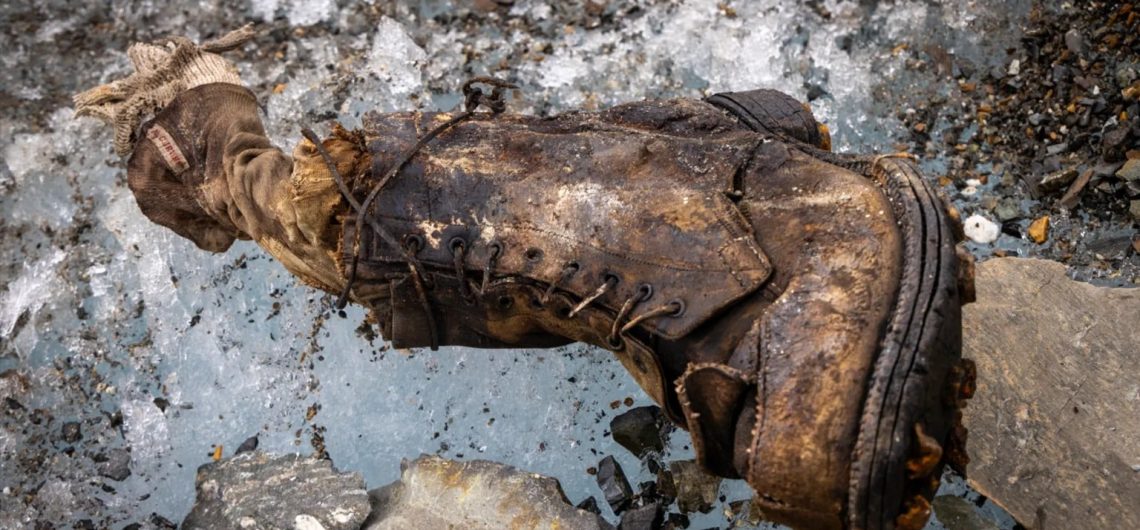
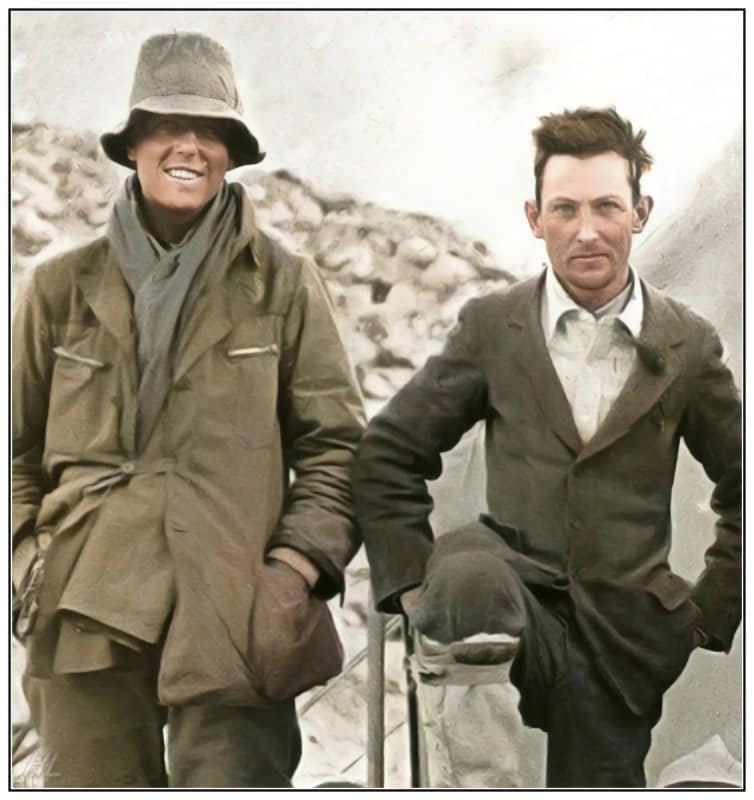
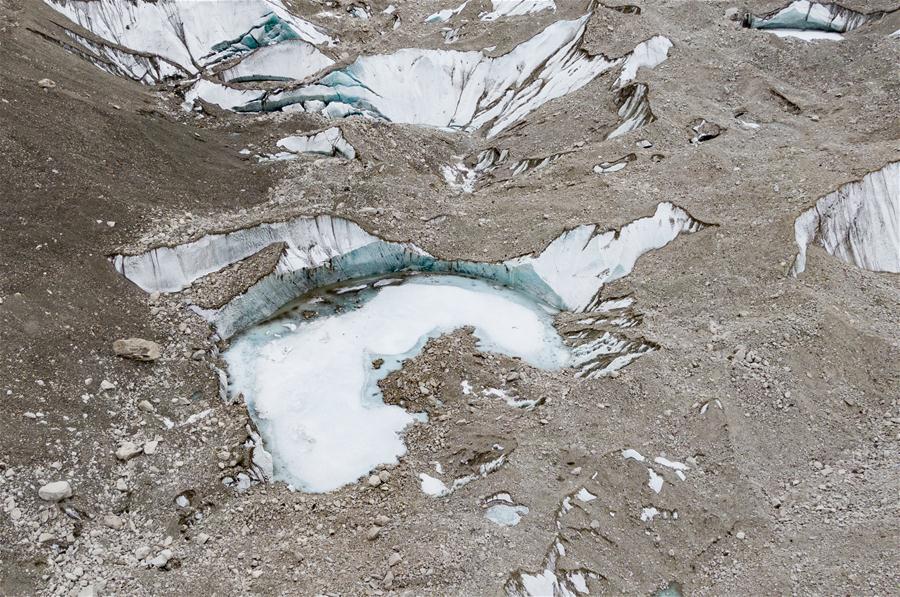

Comments